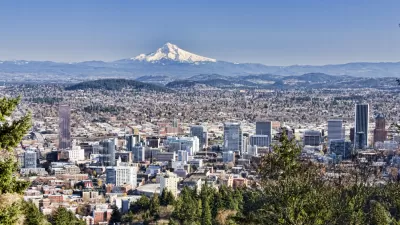Two new research hubs will explore the intersections between homelessness, technology, and urban planning.

A new initiative at Portland State University will make homelessness a top priority for departments ranging from land-use planning to education and linguistics. The $3 million investment will create two multidisciplinary research hubs aimed at promoting smart solutions to problems in housing, technology, and transportation.
The Digital City Testbed Center will study how new technologies can be applied in transportation and urban planning to improve efficiency, sustainability, and public health in Portland and other cities. And the Homelessness Research and Action Collaborative will explore solutions and preventative measures for homelessness, and craft public messaging around the issue.
Both centers will operate as a three-year pilot with the goal of attracting outside investment and making an impact in their fields. If successful, the university may expand the initiative to create seven similar centers.
More than 4,000 Portland residents don't have a permanent home, according to Oregon Live.
FULL STORY: Portland State invests $3 million to research homelessness, 'smart cities'

Maui's Vacation Rental Debate Turns Ugly
Verbal attacks, misinformation campaigns and fistfights plague a high-stakes debate to convert thousands of vacation rentals into long-term housing.

Planetizen Federal Action Tracker
A weekly monitor of how Trump’s orders and actions are impacting planners and planning in America.

In Urban Planning, AI Prompting Could be the New Design Thinking
Creativity has long been key to great urban design. What if we see AI as our new creative partner?

King County Supportive Housing Program Offers Hope for Unhoused Residents
The county is taking a ‘Housing First’ approach that prioritizes getting people into housing, then offering wraparound supportive services.

Researchers Use AI to Get Clearer Picture of US Housing
Analysts are using artificial intelligence to supercharge their research by allowing them to comb through data faster. Though these AI tools can be error prone, they save time and housing researchers are optimistic about the future.

Making Shared Micromobility More Inclusive
Cities and shared mobility system operators can do more to include people with disabilities in planning and operations, per a new report.
Urban Design for Planners 1: Software Tools
This six-course series explores essential urban design concepts using open source software and equips planners with the tools they need to participate fully in the urban design process.
Planning for Universal Design
Learn the tools for implementing Universal Design in planning regulations.
planning NEXT
Appalachian Highlands Housing Partners
Mpact (founded as Rail~Volution)
City of Camden Redevelopment Agency
City of Astoria
City of Portland
City of Laramie




























